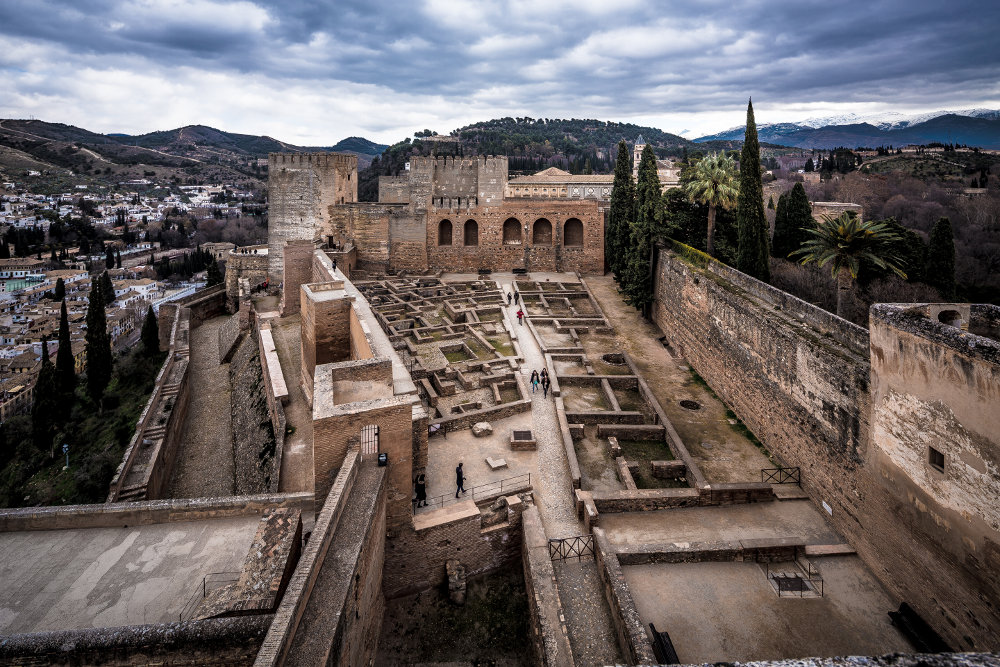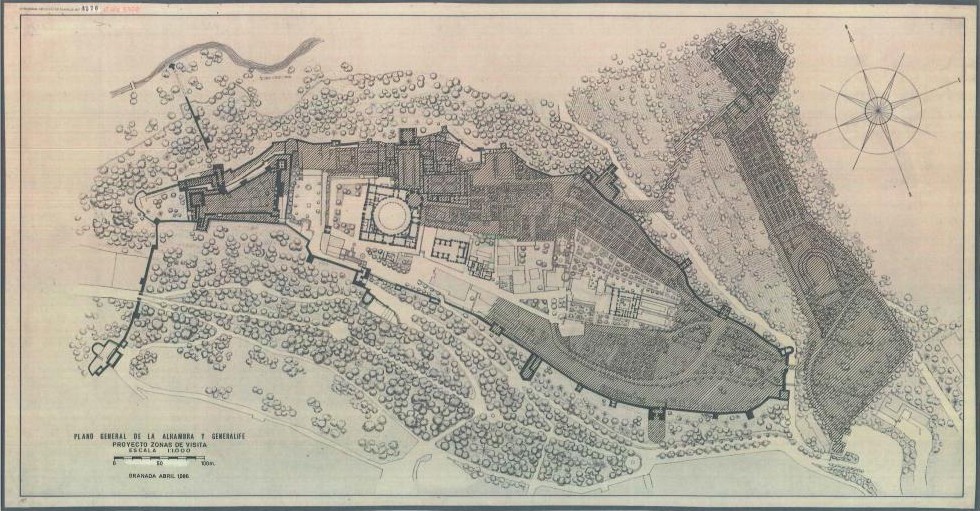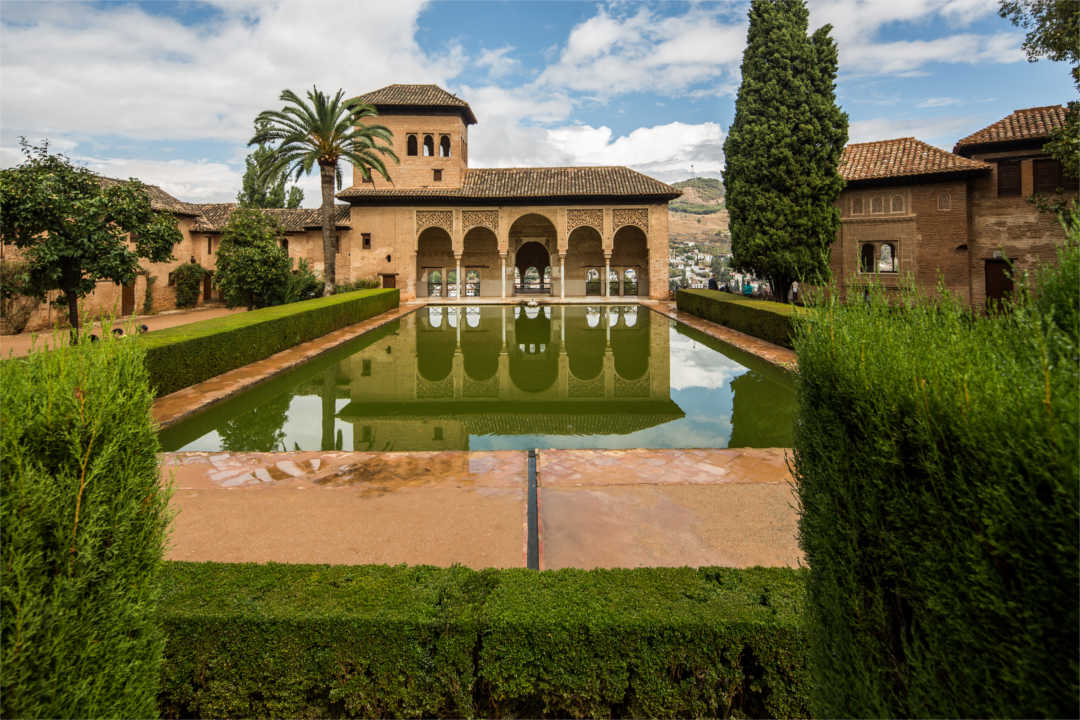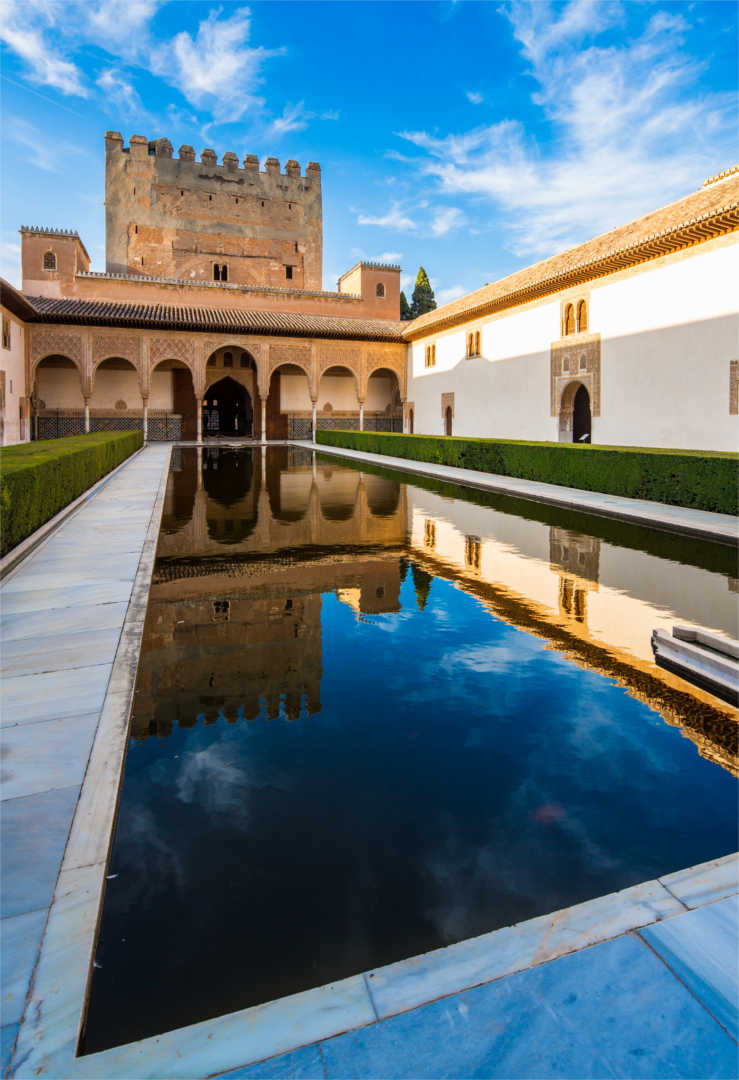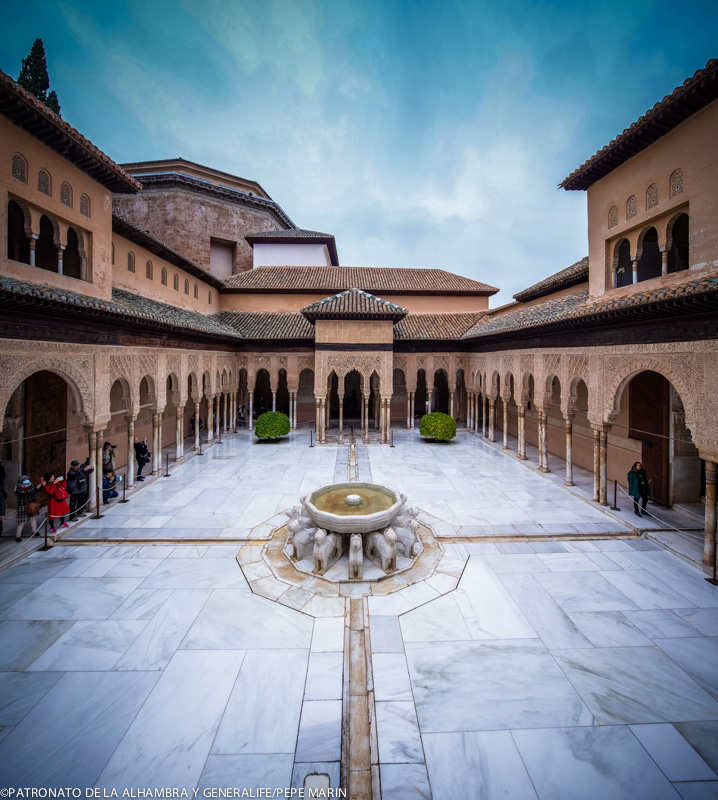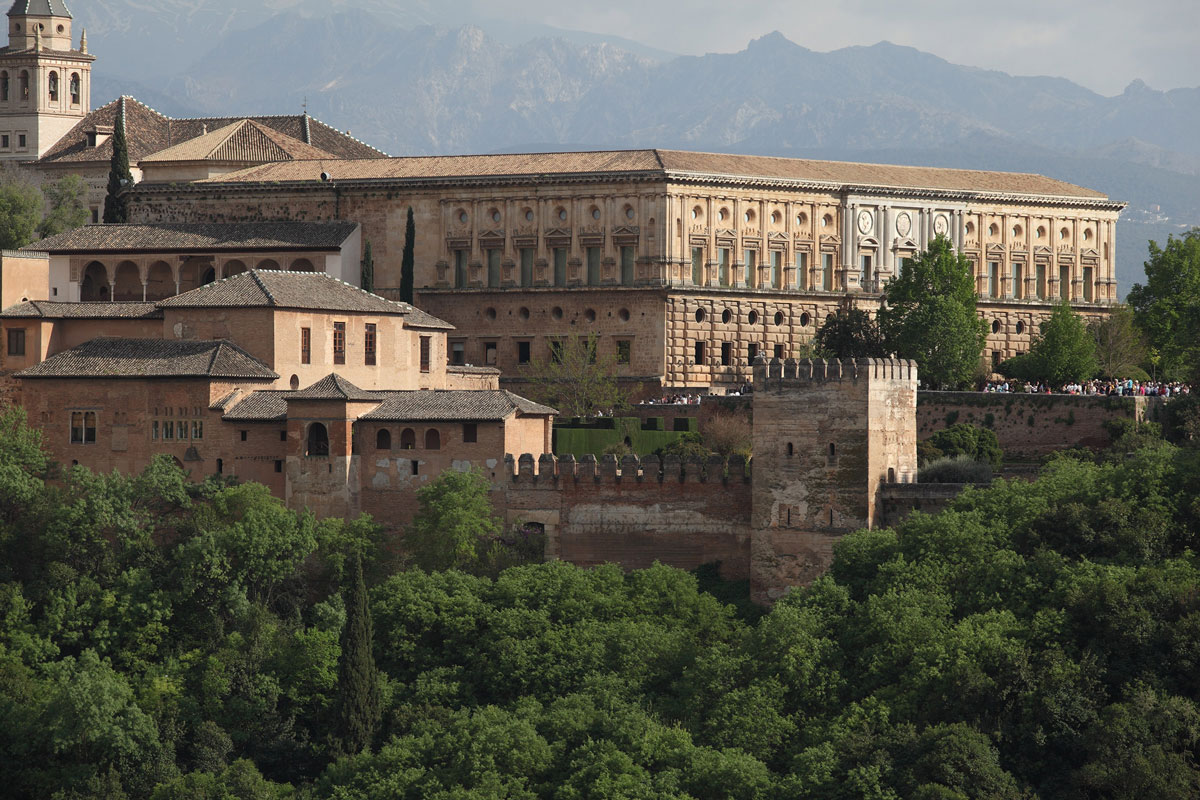THE ENCLAVE
The Alhambra is the main enclave of a complex territorial structure, demonstrating its importance through its dominion over the city of Granada.
Granada corresponds with the historic hilltop city model, surrounded by mountains and irrigated by the rivers Darro and Genil, the first dividing the land into two opposite fronts which determined the construction of the medieval city. The hills around the Darro are those of San Cristóbal (760m) on the right bank of the river and Sabika (790m), on the left bank. The Alhambra stands on the latter.
It was no accident that Muhammad I (1237-1273) selected a place with such privileged geographic conditions, also taking into account the existence of previous large fortified constructions. The high locations of cities have special characteristics and are due to geopolitical decisions consistent with the medieval mentality.
Dominance of the location and control of territory were everything in the organization of a kingdom in the 13th century, in which both military power and administrative organization required an enclave which safeguarded the physical presence of power over the city, while keeping it separated from it.
LOCATION
The Alhambra stands on the hill of Sabika, which penetrates inland to a fertile plain, as the last bastion of the Sierra Nevada, facing Albaicín and Sacromonte, between the Darro and Genil river basins.
Surrounded by mountains, Arabic writers compared Granada to a crown, with the jewel of the Alhambra protruding from it.
The history of the Alhambra’s constructions is closely related with the city of Granada, of which there is archaeological documentation of overlapping walls from the Iberian, Roman and Islamic period, successively.
The Alhambra that we see today was not built at one specific time. It was formed gradually, adding new constructions, grouped as cells, enriching its architectural and urban development.
STRUCTURE
This enormous “stranded vessel” on the hill, as classical historians called it, was formed gradually, adding new constructions.
The Alhambra is the result of development over almost two and a half centuries under the Nasrids, as well as the previous constructions, along with the important contributions and modifications made in the Christian period, and which continued practically until the present day.
In this way, the Alhambra that we know today was structured, with the most important milestones detailed below:
LA ALCAZABA
Possibly the oldest occupied place in the whole of the Alhambra, or at least the part from which the oldest information comes. Its location, on the highest area of the hill, makes it a privileged place for observation and monitoring of the surroundings, of the city, the plain and its points of access.
The triangle marked on the ground survives from the 11th century constructions, although the only certainty of this period is the section of the interior wall to the north, and the door of its upper enclosure. In the 12th century, the Almoravids carried out some work and adaptations on the Alcazaba.
THR FORTIFIED ALHAMBRA
In the 13th century, the Nasrids gave the Alcazaba its current appearance, adding large towers to it: the Vela tower to the west and the Homenaje, Quebrada and Adarguero towers to the east. The whole enclosure was surrounded on the exterior with a patrol road and the important access through the Puerta de las Armas.
From then, the walling and fortification of the whole perimeter of the Alhambra began with its walls, adding some towers and doors at intervals along its perimeter.
FIRST CONSTRUCTIONS
With the structure of the inner walls defined, the first palaces were built. A large Mexuar preceded by patios lay before the Palacio de Isma’il, which no longer stands. The Generalife and the essential core of the Palacio del Partal, the oldest surviving Nasrid constructions, shape a palatial space open toward the city, designed as a palatial area of buildings, enclosures and gardens.
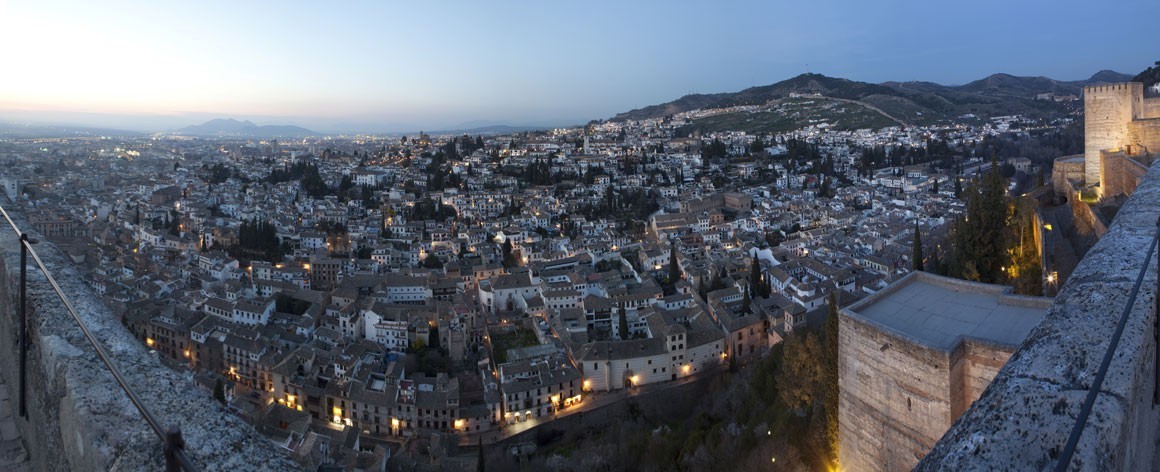
PALACIO DE COMARES
On some of the previous constructions, adding and modifying structures, Yusuf I became the first great builder of the Alhambra. Although he would not see it completed, he built the Palacio de Comares, as well as the large Puertas de la Justicia and Siete Suelos, along with many other constructions and decorations of the Alhambra.
In the first half of the 14th century, the Mosque, the Rauda, the Madraza and the Palacios de San Francisco and Abencerrajes were added.
PALACIO DE LOS LEONES
In the second half of the 14th century, a great modification was made to the internal structure of the Alhambra. Coinciding with the second mandate of Muhamnad V, in the most prolific period for the Nasrids, he decorated and redecorated the majority of the spaces that we see today.
His great construction, the Palacio de los Leones, breaks away from the usual architectural layout, bringing new aesthetic and formal concepts which were also reflected in the administration of the State and the matters of the Court.
THE CHRISTIAN ALHAMBRA
The final and most radical transformation of the Alhambra occurred after the conquest. New concepts imposed new uses with significant modifications to buildings and urban elements.
The main modification is certainly the Palacio de Carlos V which, although never having been finished, added a new volume to the buildings of the Alhambra, inserting itself, like its predecessors, as another space.
In the 16th century, the outer wall was added to the east of the Alcazaba with the circular Cubo tower, and the large Tendilla cistern at its base. In the 17th century, the Jardín de los Adarves was created between the southern walls.
The Patios of Lindaraja and La Reja, the Church of Santa María, the Convent of San Francisco, and the Pillar of Carlos V, are some of the contributions to the Alhambra, contributing to creating its rich cultural stratification.
LANDSCAPE
The Alhambra stands on the hill of la Sabika, between the Darro and Genil river basins. Surrounded by mountains, Arabic writers compared Granada to a crown, with the jewel of the Alhambra protruding from it.
Without doubt, the Alhambra occupies a privileged location, where its architectural values are combined and perfectly integrated with the urban surroundings and the landscape in which it is immersed.
To appreciate the architectural and scenic values of the Alhambra, it is recommended to visit the Albaicín quarter (Mirador de San Nicolás) or Sacromonte. From these points, the spectacular relationship of the Alhambra with the territory and the city of Granada can be observed.





 Contact
Contact






